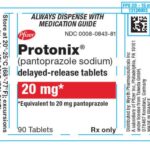Can Omeprazole Mess With Your Period?

Menstruation is the shedding of the lining of the uterus (endometrium) accompanied by bleeding. It occurs in approximately monthly cycles throughout a woman’s reproductive life, except during pregnancy. Menstruation starts during puberty (at menarche) and stops permanently at menopause.
By definition, the menstrual cycle begins with the first day of bleeding, which is counted as day 1. The cycle ends just before the next menstrual period. Menstrual cycles normally range from about 25 to 36 days. Only 10 to 15% of women have cycles that are exactly 28 days. Also, in at least 20% of women, cycles are irregular. That is, they are longer or shorter than the normal range. Usually, the cycles vary the most and the intervals between periods are longest in the years immediately after menstruation starts (menarche) and before menopause.
Menstrual bleeding lasts 3 to 7 days, averaging 5 days. Blood loss during a cycle usually ranges from 1/2 to 2 1/2 ounces. A sanitary pad or tampon, depending on the type, can hold up to an ounce of blood. Menstrual blood, unlike blood resulting from an injury, usually does not clot unless the bleeding is very heavy.
The menstrual cycle is regulated by hormones. Luteinizing hormone and follicle-stimulating hormone, which are produced by the pituitary gland, promote ovulation and stimulate the ovaries to produce estrogen and progesterone. Estrogen and progesterone stimulate the uterus and breasts to prepare for possible fertilization.
What is Omeprazole?
Omeprazole, sold under the brand names Prilosec and Losec among others was first made in 1979 by Swedish AB Hässle, part of Astra AB. It was the first of the proton pump inhibitors (PPI). Astra AB, now AstraZeneca, launched it as an ulcer medicine under the name Losec in Sweden. It was first sold in the United States in 1989 under the brand name Losec.
Omeprazole is used to treat certain conditions where there is too much acid in the stomach. It is used to treat gastric and duodenal ulcers, erosive esophagitis, and gastroesophageal reflux disease (GERD). GERD is a condition where the acid in the stomach washes back up into the esophagus. Sometimes, omeprazole is used in combination with antibiotics (eg, amoxicillin, clarithromycin) to treat ulcers associated with the infection caused by the H. pylori bacteria.
Omeprazole is also used to treat Zollinger-Ellison syndrome, a condition where the stomach produces too much acid. Omeprazole is also used to treat dyspepsia, a condition that causes sour stomach, belching, heart burn, or indigestion.
In addition, omeprazole is used to prevent upper gastrointestinal tract bleeding in seriously ill patients. Omeprazole is a proton pump inhibitor (PPI). It works by decreasing the amount of acid produced by the stomach.
How should omeprazole be used?
Prescription omeprazole comes as a delayed-release (releases the medication in the intestine to prevent break-down of the medication by stomach acids) capsule, and packets of delayed-release (releases the medication in the intestine to prevent break-down of the medication by stomach acids) granules for suspension (to be mixed with liquid) to take by mouth or give through a feeding tube. Nonprescription (over-the-counter) omeprazole comes as a delayed-release tablet to take by mouth. Prescription omeprazole should be taken at least 1 hour before a meal. Prescription omeprazole is usually taken once a day before a meal but may be taken twice a day when used with other medications to eliminate H. pylori, or up to three times a day, before meals when used to treat conditions in which the stomach produces too much acid.
The nonprescription delayed-release tablets are usually taken once a day in the morning at least 1 hour before eating for 14 days in a row. If needed, additional 14-day treatments may be repeated, not more often than once every 4 months. To help you remember to take omeprazole, take it at around the same time(s) every day. Follow the directions on your prescription label or the package label carefully, and ask your doctor or pharmacist to explain any part you do not understand. Take omeprazole exactly as directed. Do not take more or less of it or take it more often or for a longer period of time than prescribed by your doctor or stated on the package.
If you are taking the delayed-release tablets, swallow them whole with a full glass of water. Do not split, chew, or crush them or crush and mix them into food.
Swallow the delayed-release capsules whole. If you have difficulty swallowing the delayed-release capsules, place one tablespoon of soft, cool applesauce in an empty bowl. Open the delayed-release capsule and carefully empty all the granules inside the capsule onto the applesauce. Mix the granules with the applesauce and swallow the mixture immediately with a glass of cool water. Do not chew or crush the granules. Do not store the applesauce/granule mixture for future use.
If you are taking the granules for oral suspension, you will need to mix it with water before use. If you are using the 2.5-mg packet, place 1 teaspoonful (5 mL) of water in a container. If you are using the 10-mg packet, place 1 tablespoonful (15 mL) of water in a container. Add the contents of the powder packet and stir. Wait 2 to 3 minutes to allow the mixture to thicken, and stir the mixture again. Drink the entire mixture within 30 minutes. If any of the mixture is stuck to the container, pour more water into the container, stir and drink all the mixture immediately.
The granules for oral suspension can be given through a feeding tube. If you have a feeding tube, ask your doctor how you should take the medication. Follow the directions carefully.
Do not take nonprescription omeprazole for immediate relief of heartburn symptoms. It may take 1 to 4 days for you to feel the full benefit of the medication. Call your doctor if your symptoms get worse or do not improve after 14 days or if your symptoms return sooner than 4 months after you finish your treatment. Do not take nonprescription omeprazole for longer than 14 days or treat yourself with omeprazole more often than once every 4 months without talking to your doctor.
Continue to take prescription omeprazole even if you feel well. Do not stop taking prescription omeprazole without talking to your doctor. If your condition does not improve or gets worse, call your doctor.
Does omeprazole affect menstrual cycle?
Omeprazole is metabolized by enzymes that are modulated by estrogen and progesterone which regulate the menstrual cycle. Higher levels of these enzymes activity in women may be associated with higher endogenous progesterone concentrations.
Progesterone helps to regulate your cycle. But its main job is to get your uterus ready for pregnancy. After you ovulate each month, progesterone helps thicken the lining of the uterus to prepare for a fertilized egg. If there is no fertilized egg, progesterone levels drop and menstruation begins. You Can Find Additional Information On: Is Tinnitus From Omeprazole Permanent?





